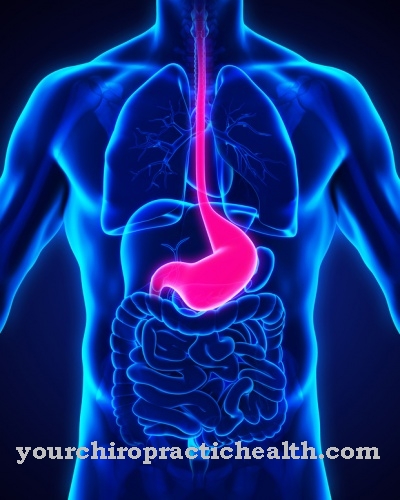Cytarabine is a cytostatic and is mainly used to treat acute myeloid leukemia. In this indication, it is one of the most frequently used cytostatics. It is also used in acute lymphoblastic leukemia (also: acute lymphatic leukemia), myelodysplastic syndrome and non-Hodgkin lymphoma. Cytarabine also has a virostatic effect, but is not used as an antiviral agent.
What is cytarabine?
Cytarabine is an isomer of the nucleoside cytidine belonging to the group of arabinosyl nucleosides. Instead of the β-D-ribofuranose common with nucleosides, it has a β-D-arabinofuranose.
Cytarabin is made up of a furanose (sugar) and cytosine. The chemical formula of the substance is C9H13N3O5. The cytarabine has a molar mass of 243.17 g x mol ^ -1 and is a colorless solid. Cytarabine is readily soluble in water. The melting point is 212-213 degrees Celsisu.
Cytarabine is a cytostatic agent and is classified as an antimetabolite due to its mechanism of action. The lethal dose 50 in rats is> 5 mg x kg ^ −1 after intravenous administration and> 500 mg x kg ^ −1 after oral administration. Furthermore, cytarabine also has a virostatic effect, but is rarely used as a virostatic.
Pharmacological effect
Cytarabine is used as a cytostatic drug. The substance acts as an antimetabolite, i.e. the cytarabine resembles a natural metabolite and inhibits its metabolic pathway. Via this mechanism, the cytarabine disrupts a normal process (in this case DNA replication). This is the cause of the cytostatic effect. The cytotoxicity is then used medically for the treatment of cancer diseases.
In order to clarify the mechanism of action of cytarabine, it must first be said that cytarabine is phosphorylated in the body to cytosine arabinoside triphosphate. Cytosine arabinoside triphospaht is the actual active substance. This substance is incorporated into the DNA instead of the nucleotide cytidine triphosphate during DNA replication.
The active form of cytarabin replaces the DNA building block cytidine triposphate. This is possible because the cytarabine is chemically similar to the cytidine triposphate. Furthermore, cytarabine blocks the DNA repair mechanisms. Overall, the cytarabine has a cytotoxic, i.e. cell-damaging effect via the processes described. The cytotoxic effect occurs almost exclusively during the S phase of the cell cycle.
Regarding the pharmacokinetics of cytarabine, it can be said that cytarabine can pass through the liquor with intravenous and subcutaneous administration. After oral administration, less than 20% of the administered cytarabine is absorbed into the bloodstream.
Cytarabine can also be administered intrathecally (into the subarachnoid space). In high doses it is able to cross the blood-brain barrier and can therefore also develop an effect in the brain.
The plasma protein binding of the substance is 13%. The metabolism takes place in the liver. Cytarabine is metabolized to the two metabolites cytosine-arabinoside-triphosphate and uracil-arabinoside, the former being active and the latter not. Elimination takes place via cytosine deaminases in the liver and kidneys.
Medical application & use
Cytarabine is used medically as a cytostatic agent. The main area of application of the active ingredient is acute myeloid leukemia (AML). Cytarabine is one of the most important cytostatics and is administered in almost every AML treatment.
The substance is also used in acute lymphoblastic leukemia. A frequently used scheme is the so-called 7 + 3 scheme, in which cytarabine is administered over a period of seven days and then a substance from the group of anthracyclines is administered for three days.
The indications for cytarabins are acute myeloid leukemia (AML), acute lymphoblastic leukemia (ALL), myelodysplastic syndrome (MDS) and non-Hodgkin lymphoma (NHL) in children and adolescents as well as in adults. The dosage of the cytostatic agent depends on the disease to be treated and on the age, size and body weight of the patient.
You can find your medication here
➔ Medicines against swelling of the lymph nodesRisks & side effects
The cytotoxic effect of cytarabin affects not only the degenerate cancer cells but also healthy cells of the organism. This can lead to sometimes serious side effects. It should be noted, however, that in many cases these side effects have to be accepted in order to save the patient's life. If left untreated, the diseases for which cytarabine is indicated are fatal.
The side effects include: Hair loss (alopecia), feeling sick (nausea), bone marrow depression (damage to the bone marrow that leads to reduced blood cell production), vomiting (vomiting), anemia (anemia has a reduced level of hemoglobin and an insufficient number of erythrocytes, which means that not enough oxygen can be transported).
In addition, thrombocytopenia (a reduced number of blood platelets, so-called thrombocytes, in the blood), neutropenia (neutropenia is a reduction in neutrophil granulocytes, a subtype of leukocytes, in the blood), meningitis (meningitis), dyspnoea (shortness of breath), mucosal disease ( Inflammation of the mucous membranes) and liver damage are regular side effects.
























.jpg)



